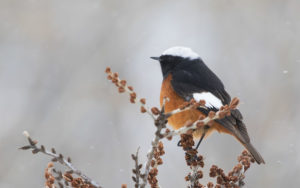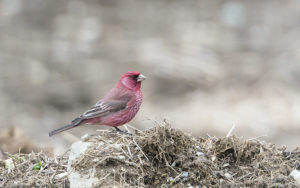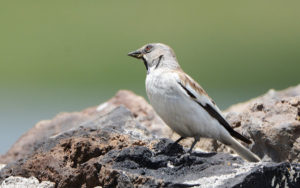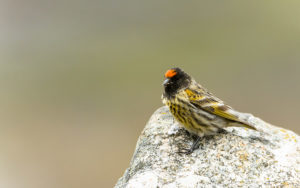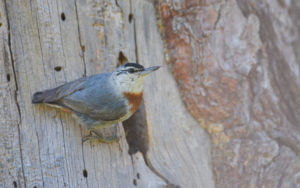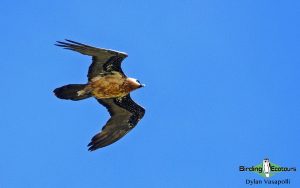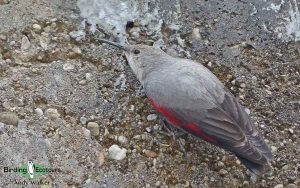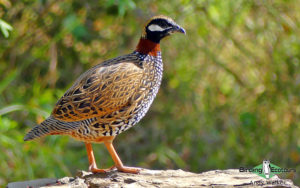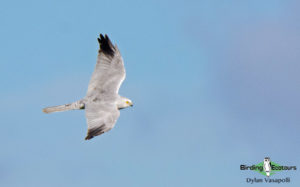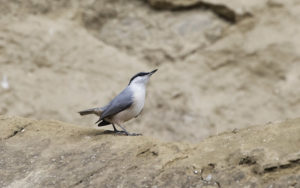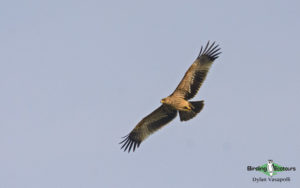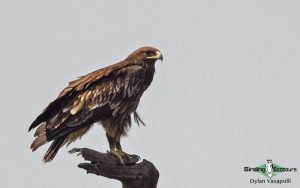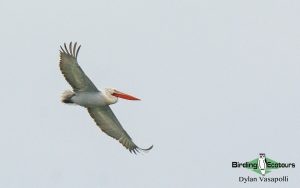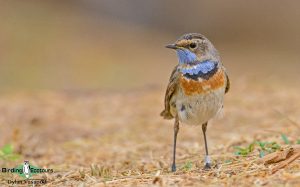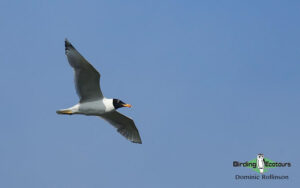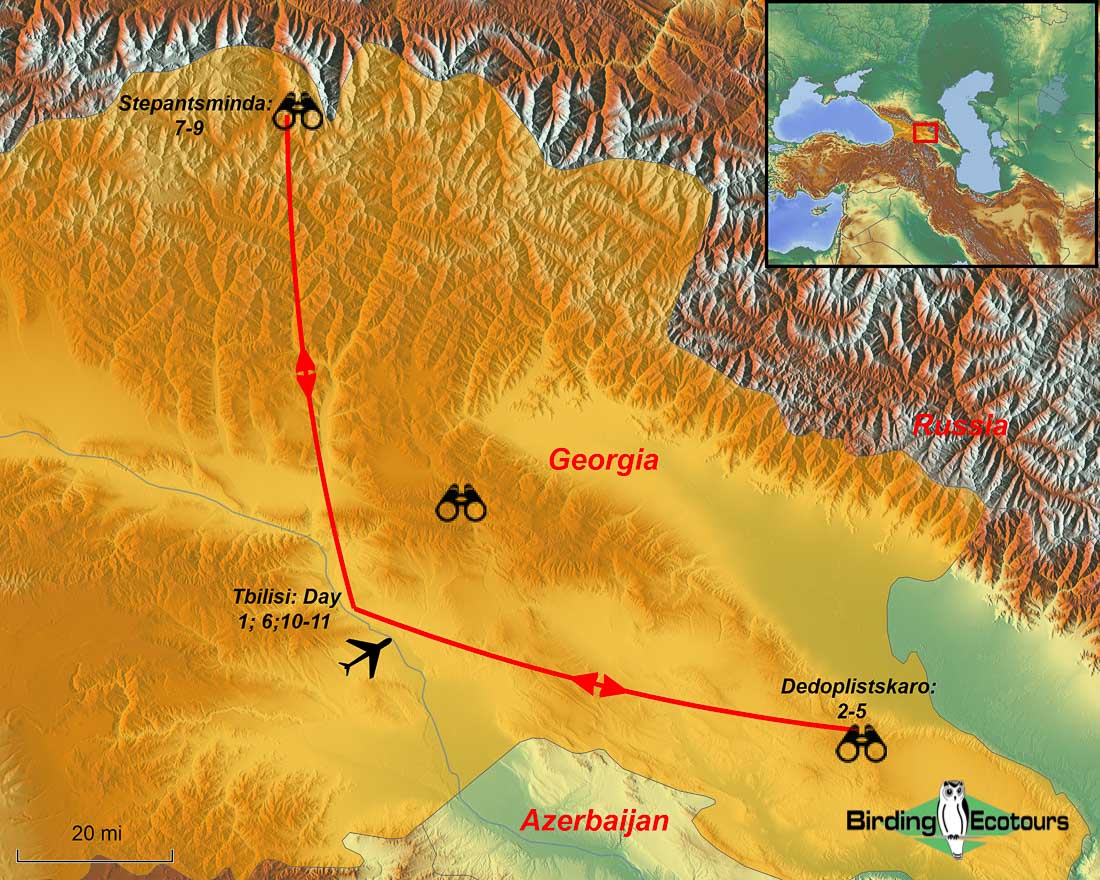Georgia: Mountain and Steppe Birding in Winter
Georgia Birding Tour: Mountain and Steppe Birding in Winter
March 2026
Georgia is a country of mystery, varied landscape, incredible food, and sensational wildlife. This tour, along with our Georgia Birding Tour: Eagles and Endemics in Fall tour, will allow you to experience this wonderful country firsthand and we are incredibly excited to now offer these two exciting tours here. Georgia is located between the Black Sea and Caspian Sea, right where Europe and Asia meet which results in a heterogenous mix of birds of Asian and European origin.
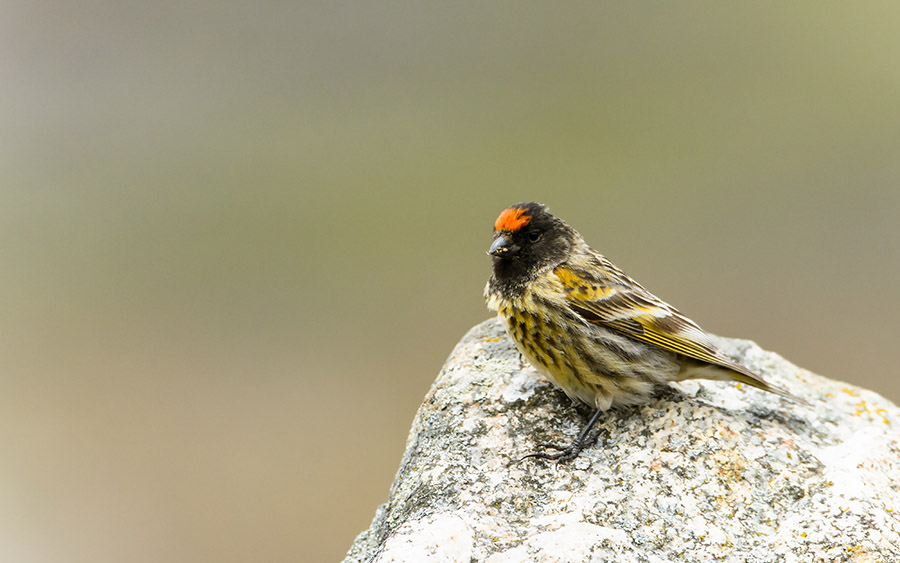 Red-fronted Serin is a gorgeous bird and we will be on the lookout for it during the tour. (Folkert de Boer)
Red-fronted Serin is a gorgeous bird and we will be on the lookout for it during the tour. (Folkert de Boer)
Following International Ornithological Congress (IOC) taxonomy (v13.1 in July 2023), the bird list of Georgia is currently 424 species, with many of these being highly sought-after due to their small global range or the issues associated with accessing them in other parts of their distribution. During the tour we will visit several Important Bird Areas (IBAs), sites that have been identified by BirdLife International as holding significant importance for birds. Examples of IBAs we will visit include The Iori Plateau, Alazani Valley, Lagodekhi Nature Reserve, and Kazbegi.
On this tour we will get to grips with four of Georgia’s “Big Five”; Caucasian Snowcock, Caucasian Grouse, Great Rosefinch (Caucasian endemic rubicilla subspecies), and Güldenstädt’s Redstart. The fifth species of the “Big Five” is Caspian Snowcock and we look for that (and all of the others) during the aforementioned fall tour. In addition to these amazing birds, we will target other species and interesting subspecies, including Black Francolin, Little Bustard, Dalmatian Pelican, Pygmy Cormorant, Pallas’s Gull, Alpine Chough, Pine Bunting, Mountain Chiffchaff (local lorenzii subspecies and potential split), Western Rock Nuthatch, Krüper’s Nuthatch, Wallcreeper, Spanish Sparrow, Red-fronted Serin, Horned (Shore) Lark (penicillata subspecies), Water Pipit (coutelli subspecies), Twite (brevirostris subspecies), and a range of raptors including Bearded Vulture, Griffon Vulture, Cinereous Vulture, Eastern Imperial Eagle, Steppe Eagle, Pallid Harrier, Lanner Falcon, and Saker Falcon.
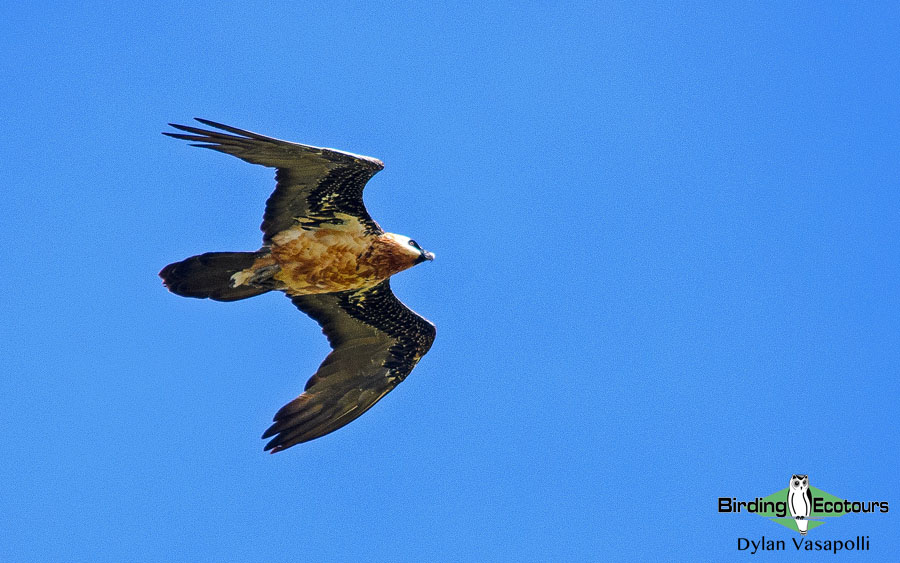 Great views of Bearded Vulture in stunning scenery will be possible.
Great views of Bearded Vulture in stunning scenery will be possible.
We begin our sensational 11-day tour in Georgia’s ancient capital, Tbilisi. After your long flight you may want to relax but we also have the option of some very casual birding in the city where we can catch up with species like Krüper’s Nuthatch, Syrian Woodpecker, Middle Spotted Woodpecker, Lesser Spotted Woodpecker, Common Firecrest, Hawfinch, and others.
The following morning, we then begin our journey east to the remote Kakheti region. This area of plains, steppes, and lakes is one of the most unexplored areas of Georgia and its location, close to neighboring Azerbaijan, makes it an incredibly exciting region to explore. We will visit some of the best lakes in the region where top species reside, like Pallas’s Gull, Dalmatian Pelican, and Armenian Gull. The grasslands around the lakes should give us the stunning Black Francolin. Georgia is also famed for its birds of prey with rare species like Eastern Imperial Eagle and Cinereous Vulture being some of our targets in this area. These lakes are also an excellent area for passerines like Bluethroat, Moustached Warbler, and Spanish Sparrow.
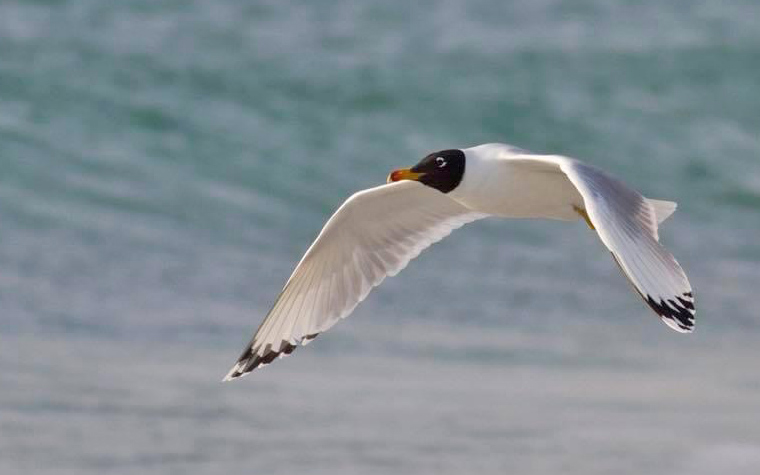 The mighty Pallas’s Gull is a real standout species of eastern Georgia and a superb bird to see in the Western Palearctic (photo Tim Jones).
The mighty Pallas’s Gull is a real standout species of eastern Georgia and a superb bird to see in the Western Palearctic (photo Tim Jones).
From the Kakheti region we will then head further into the steppes towards the David Gareja Monastery, one of Georgia’s most famous historical monuments and right on the border with Azerbaijan. Exciting passerines will again be the target here with significant numbers of Eurasian Skylark and Calandra Lark likely to be found. We will check these flocks carefully as rarer eastern lark species may be hiding within, maybe something like a White-winged Lark! The monastery is an excellent spot to look for Western Rock Nuthatch and Wallcreeper (a monotypic family and much desired species), and the scrub around it may give up Chukar Partridge.
Moving further east we will enter the land of the raptors with several great species present, including Eastern Imperial Eagle, Long-legged Buzzard, Rough-legged Buzzard, Lanner Falcon, Saker Falcon, and Pallid Harrier. Interesting passerines are present here too, with Isabelline Wheatear, Rock Sparrow, Great Grey Shrike, Greater Short-toed Lark, Turkestan Short-toed Lark, and Corn Bunting being some of the standout species. We should also find large groups of Little Bustard here, part of the world’s largest wintering concentration of this species, plus the fantastic Goitered Gazelle.
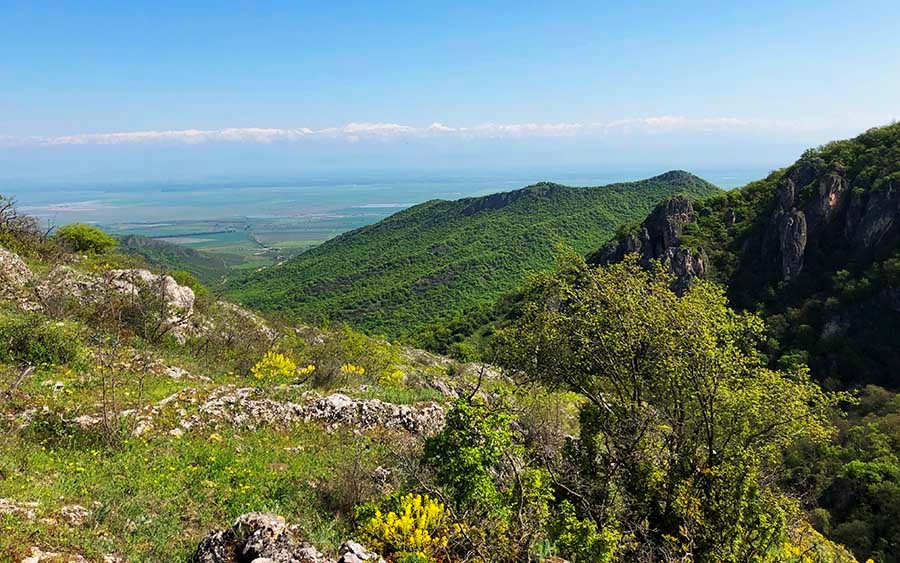 Eagle Gorge is a beautiful place and full of great birds (photo Alexander Rukhaia).
Eagle Gorge is a beautiful place and full of great birds (photo Alexander Rukhaia).
From the steppes we head west, stopping in the famous Eagle Gorge, for species like Griffon Vulture, Black Stork, Red-fronted Serin, and Wallcreeper, and the beautiful Lagodekhi Forest in the northeast corner of Georgia. Here we can find the prized White-backed Woodpecker, plus other species like Black Woodpecker, Middle Spotted Woodpecker, and common passerines.
It will then be time to turn north towards the famous Kazbegi region. Here is where we will focus on four of Georgia’s “Big Five” birds, plus species like Wallcreeper, Red-fronted Serin, White-winged Snowfinch, White-throated Dipper, Alpine Accentor, Alpine Chough, Bearded Vulture, Golden Eagle, and the interesting Caucasian subspecies of Twite, Water Pipit, and Horned (Shore) Lark. We may also see the endemic Eastern Tur, a striking goat-antelope found only in the Greater Caucasus Mountains, Red Fox, and Grey Wolf, with the timing of our visit well suited for seeing all three species. Sadly, eventually, we must then make our way south, back towards Tbilisi where the tour ends.
Itinerary (11 days/10 nights)
Day 1. Arrival in Tbilisi, optional birding in and around the city
Welcome to Georgia’s capital, Tbilisi. You will be met at the airport by your guiding team made up of your Birding Ecotours tour leader and our expert Georgian local guide. After arriving on your morning flight, you will be transferred to your comfortable city hotel to freshen up and relax after your long journey.
We have the option to get straight into discovering Georgia’s amazing birds with some optional visits to a range of local birdwatching sites around the city (you can choose to just relax in the hotel if you would prefer that, or maybe plan on arriving in Tbilisi the day before the tour starts for some additional acclimatizing). The first site we plan to visit is the Ponichala Reserve. Here we will get to grips with several stunning woodpeckers including Middle Spotted Woodpecker, Lesser Spotted Woodpecker, European Green Woodpecker, and Syrian Woodpecker.
We should also have little trouble finding common and widespread European species here, like Common Blackbird, Common Buzzard, Rock Dove (wild, not just feral birds), Hooded Crow, Northern Raven, Common Wood Pigeon, Eurasian Jay, Eurasian Magpie, European Robin, European Goldfinch, European Greenfinch, Brambling, Mistle Thrush, and Long-tailed Tit. The river that flows through the park is worth checking carefully as Armenian Gull, Western Marsh Harrier, and Osprey can all be found here.
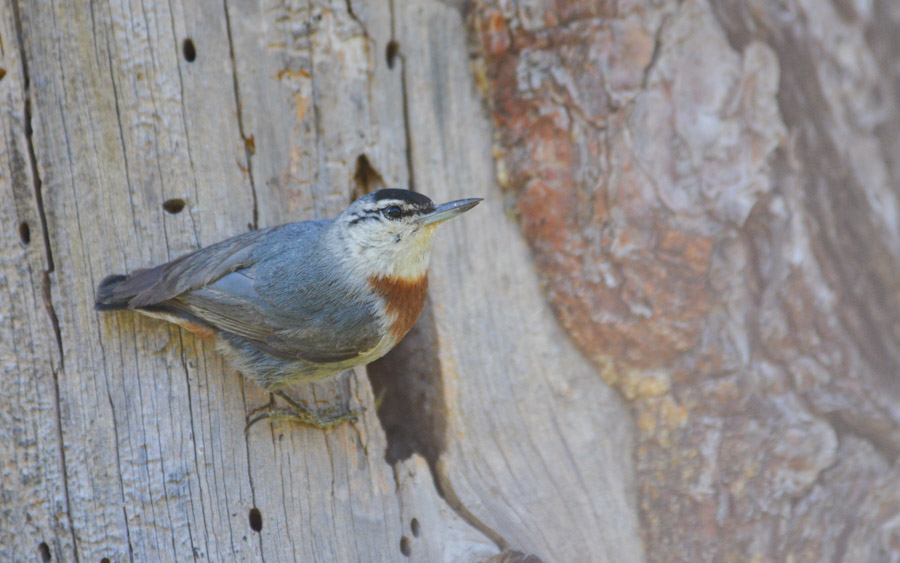 The beautiful Krüper’s Nuthatch can be found near Tbilisi (photo Eleni Galinou).
The beautiful Krüper’s Nuthatch can be found near Tbilisi (photo Eleni Galinou).
We can also drive to a local pine woodland just outside the city. Here we stand a good chance of finding the rather special Krüper’s Nuthatch, a potential early tour highlight. Additional common species will also be present with Goldcrest, Common Firecrest, Hawfinch, Common Chaffinch, Great Tit, Eurasian Blue Tit, and Coal Tit being the most likely species.
Regardless of whether you feel energetic enough to do this birding or not, we will all enjoy a traditional Georgian meal in the evening (expect plenty of fantastic and interesting food!) and have a walk around old Tbilisi where we can enjoy the best this beautiful city has to offer.
Overnight: Tbilisi
Day 2. Kumisi Lake, Jandari Lake, David Gareji Monastery, and the steppes
Today we will begin our adventure into the remote eastern part of Georgia. We will make an early start, first taking in a traditional Georgian breakfast, and head towards Kumisi Lake. This artificial lake, created during the Soviet era, used to be an important fishing area but those days are now over. However, the birding here is absolutely superb with key European species like the Near Threatened (BirdLife International) Dalmatian Pelican, along with Pygmy Cormorant, Armenian Gull, and the striking Pallas’s Gull, with Georgia sitting right on the edge of its western range. We should also come across a wide range of interesting wildfowl including Ruddy Shelduck, Garganey, Red-crested Pochard, and more common species like Northern Shoveler, Eurasian Teal, and Tufted Duck.
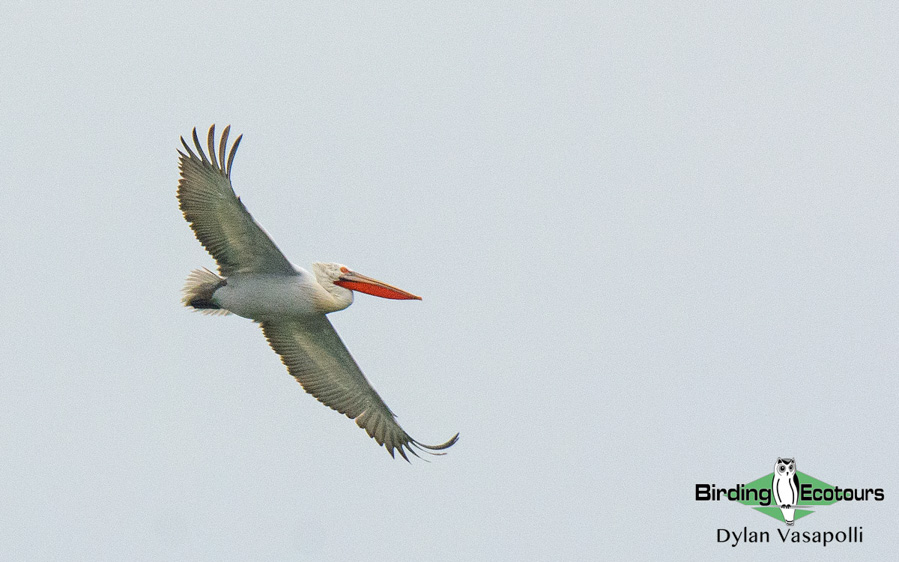 Dalmatian Pelican is a species of global conservation concern. We will look for it at Kumisi Lake today.
Dalmatian Pelican is a species of global conservation concern. We will look for it at Kumisi Lake today.
Shorebirds (waders) are well represented here as the lake is an important passage site, with Little Ringed Plover, Green Sandpiper, Kentish Plover, and Common Greenshank being regular species. We will also keep our eyes peeled for interesting birds of prey like White-tailed Eagle, Western Marsh Harrier, plus scarce species like Eastern Imperial Eagle, Steppe Eagle, Pallid Harrier, and Cinereous Vulture. The scrub areas bordering the lake should give us many of the common passerines we found in Tbilisi plus a few different and interesting species like Calandra Lark and Spanish Sparrow.
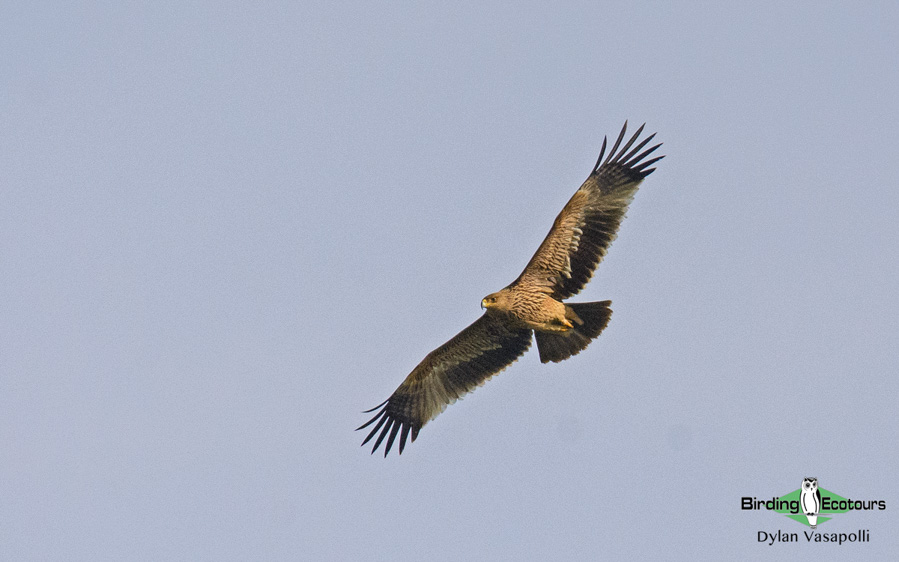 The majestic Eastern Imperial Eagle is a scarce species but is possible on this tour.
The majestic Eastern Imperial Eagle is a scarce species but is possible on this tour.
From Kumisi Lake we will then move south to the even larger Jandari Lake. This lake is in steppe country, right on the border with Azerbaijan. One of the main features of Jandari is the large gull roost, with sometimes up to 1,000 Armenian Gull being present, with far smaller numbers of Pallas’s Gull often mixed in with them. We will explore the reedbeds adjacent to the lake for some exciting passerines, such as the beautiful Bluethroat and secretive Moustached Warbler, while the steppe land around the lake should hold significant flocks of Spanish Sparrow and Eurasian Tree Sparrow. Other interesting passerines here could include Calandra Lark, Crested Lark, Siberian Stonechat, Black Redstart, Rock Sparrow, Water Pipit, Corn Bunting, Great Grey Shrike, and Cetti’s Warbler.
From Jandari we will continue east into the heart of the Georgian steppe. This remote area is home to large flocks of Calandra Lark and Eurasian Skylark and these flocks are worth checking for eastern stowaways like White-winged Lark and Oriental Skylark.
We then head to one of Georgia’s most famous landmarks, the stunning David Gareji monastery. This 1,400-year-old monastery straddles the border with Azerbaijan and is home to some special birds. Inside the ancient courtyard we will look for the striking Wallcreeper (a most-wanted monotypic family) and the attractive Western Rock Nuthatch. Around the monastery we should come across Crested Lark, highly confiding Chukar Partridge, Spanish Sparrow, Meadow Pipit, Black Redstart, Corn Bunting, and perhaps the characterful Little Owl.
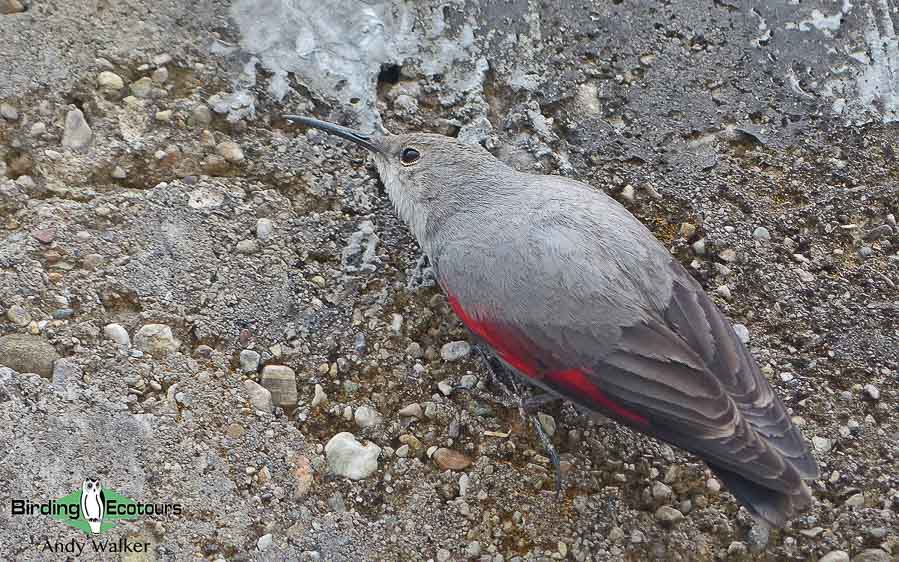 The beautiful Wallcreeper is a bird we will hopefully get quite familiar with during our tour. Georgia is one of the best countries in the region for finding this monotypic family.
The beautiful Wallcreeper is a bird we will hopefully get quite familiar with during our tour. Georgia is one of the best countries in the region for finding this monotypic family.
After finishing up at the monastery, we will then continue our journey east towards the town of Dedoplistskaro, where we will be based for the next four nights. Along the route we will keep our eyes peeled for any interesting larks or birds of prey as we traverse the steppes.
Overnight: Dedoplistskaro
Day 3. Taribana Plains, Chachuna Managed Reserve, and Dali Reservoir
The next three days will see our adventure get even more wild as we leave tarmac roads behind and explore the gravel tracks of the Taribana plains and surrounding areas. Our main area of focus today is the Chachuna Managed Reserve and Dali Reservoir. This is remote country and the bird species on offer here, especially birds of prey, really are spectacular. We begin the journey on the Taribana Plains where we will search for the large numbers of Little Bustard which winter in this part of Georgia, and neighboring Azerbaijan, the sight of these birds is sure to be spectacular! Another bird we should keep an eye out for is Common Pheasant. This is Georgia’s national bird, and it is thought that the subspecies here (colchicus) was once endemic to Georgia!
As we move deeper into this region, we will keep our eyes open for the birds of prey of the area. Aside from the Batumi Bottleneck, this is probably the best area for observing raptors in Georgia and species we could come across include Cinereous Vulture, Griffon Vulture, Eastern Imperial Eagle, Golden Eagle, Western Marsh Harrier, Hen Harrier, Eurasian Sparrowhawk, Eurasain Goshawk, White-tailed Eagle, Common Buzzard, Long-legged Buzzard, Rough-legged Buzzard, and Common Kestrel, which we will need to check carefully for the much rarer Lesser Kestrel, Merlin, and Peregrine Falcon. However, the real jewel in the crown will be if we spot the beautiful and Near Threatened (BirdLife International) Pallid Harrier.
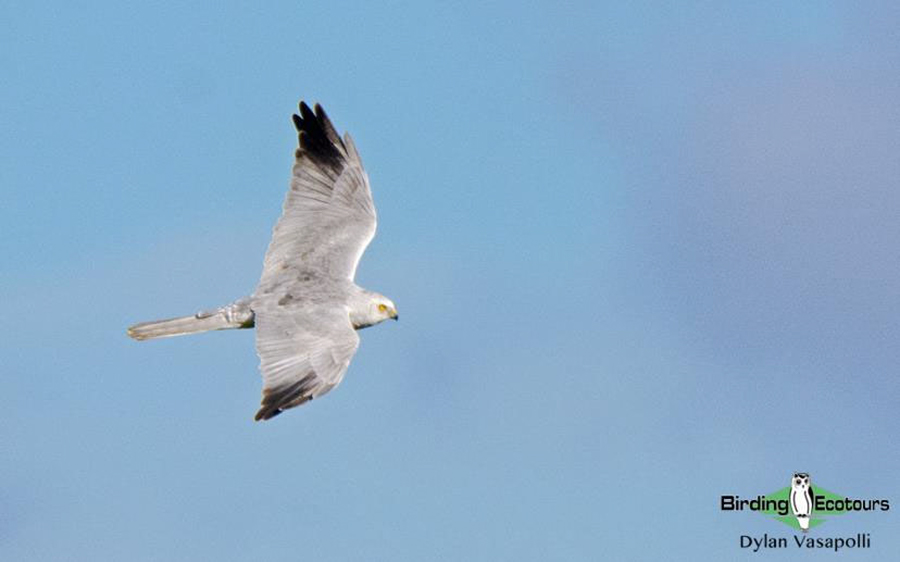 Pallid Harrier is a highly desired species on our tours, and we will put time into finding it.
Pallid Harrier is a highly desired species on our tours, and we will put time into finding it.
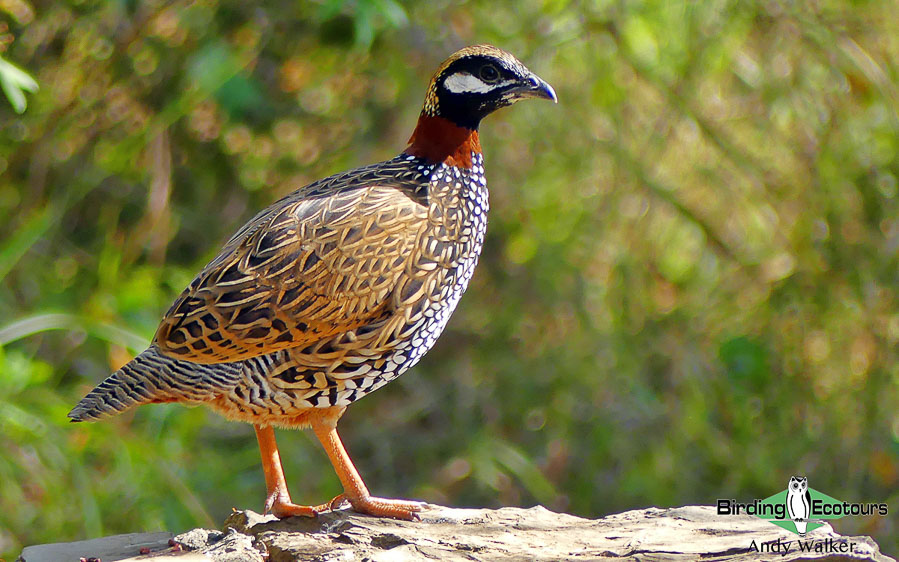 Black Francolin is a striking species mostly found in Asia. The population in Georgia, and neighboring Azerbaijan, is cut off from the species main range.
Black Francolin is a striking species mostly found in Asia. The population in Georgia, and neighboring Azerbaijan, is cut off from the species main range.
After hopefully having our fill with all these amazing birds of prey we will begin searching for the passerines which inhabit this landscape. Isabelline Wheatear, Rock Sparrow, and Corn Bunting should all be in attendance, perhaps with the rarer Pine Bunting joining the latter, and flocks of Common Linnet, Calandra Lark, Eurasian Skylark, and Spanish Sparrow should fill the fields. Other interesting species like Woodlark, Great Grey Shrike, Hawfinch, Yellowhammer and, possibly, Red-fronted Serin are also found here.
We will then head to the Dali Reservoir. The main target here is the striking Black Francolin, a member of the pheasant family which has a restricted range in the Western Palearctic. Birds of prey should also feature here too, especially vultures, and a walk to the sandy ravines around the lake should give us yet another sighting of Wallcreeper.
On the lake itself we should have little trouble finding wildfowl like Ruddy Shelduck, Mallard, Common Pochard, Tufted Duck, and rarer species like Smew, Common Goldeneye, and Northern Pintail can also be found here. After a long day we will head back to Dedoplistskaro, stopping for birding en route, if we see anything that catches our eye!
Overnight: Dedoplistskaro
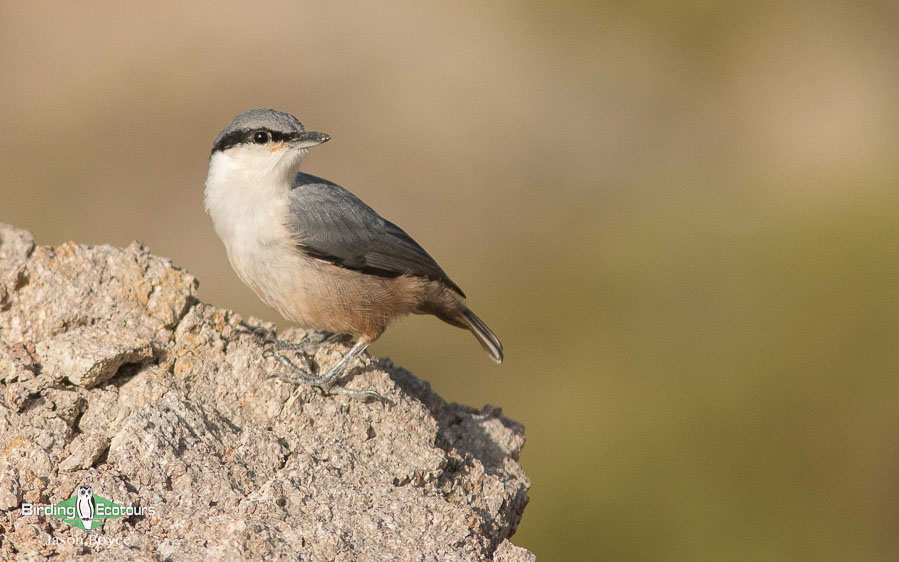 Western Rock Nuthatch is an attractive species that is a real special of rocky landscapes.
Western Rock Nuthatch is an attractive species that is a real special of rocky landscapes.
Day 4. Shiraki Plains and Vashlovai National Park
Today we will head to Georgia’s most easterly point, the Vashlovani National Park. This national park sits right on the border with Azerbaijan and the Alazani River, part of the Alazani Valley IBA, snakes right through this beautiful area. We will also visit the Shiraki Plains, another remote area which sits in the wider Iori Plateau IBA.
We will start by exploring the Shiraki Plains and we should come across thousands of Calandra Lark and Eurasian Skylark. Mixed in with them should be smaller numbers of Greater Short-toed Lark and Turkestan Short-toed Lark and we will again look for White-winged Lark and Oriental Skylark.
From here we will head into the national park and explore the deep canyon valley for species like Hawfinch, Western Rock Nuthatch, Chukar Partridge, and raptors like those we searched for yesterday. We also stand a chance of seeing the striking, and Endangered (BirdLife International) Saker Falcon in this area.
Overnight: Dedoplistskaro
Day 5. Shiraki Plains, Black Mountain, and Samukhi Valley
Today we will once again explore the Shiraki Plains but focus more on its eastern reaches. The vast flocks of Calandra Lark and Eurasian Skylark will dominate the landscape, but we will also pay close attention to raptors in the area, with Steppe Eagle, Greater Spotted Eagle, and Lesser Spotted Eagle potentially being new species for the tour. Hopefully, by now, we will also be familiar with Eastern Imperial Eagle, Hen Harrier, Pallid Harrier, Merlin, Peregrine Falcon, and Saker Falcon but if not, all these can be found here.
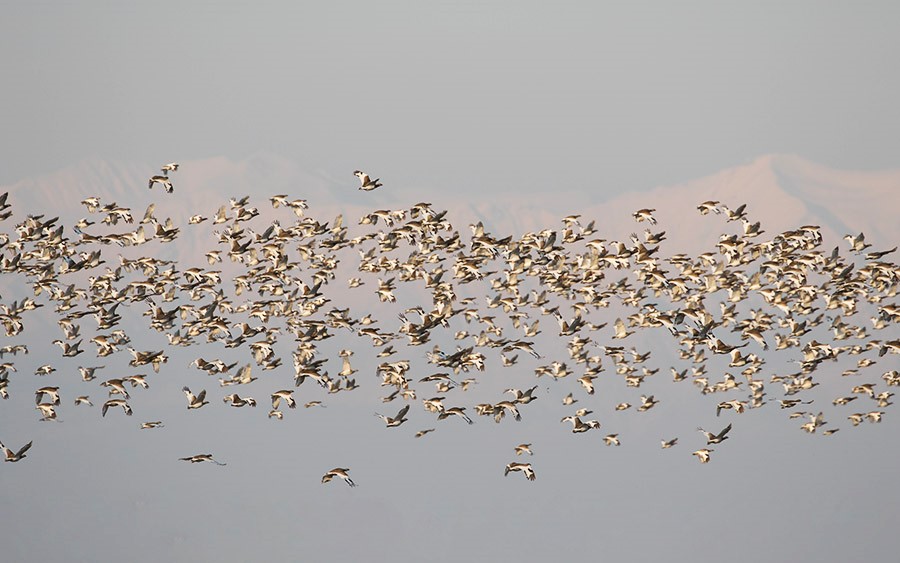 Large and significant flocks of the globally threatened Little Bustard gather in eastern Georgia during winter (photo Alexander Rukhaia).
Large and significant flocks of the globally threatened Little Bustard gather in eastern Georgia during winter (photo Alexander Rukhaia).
From the plains we head towards the Samukhi Valley via a place known as Black Mountain. One of the main target birds here is the striking Finsch’s Wheatear, which winters in small numbers in the area. We should also come across more large flocks of Little Bustard. A real goal for us in this area will also be to find the small herds of the Vulnerable (IUCN) Goitered Gazelle which are present here. This incredibly rare species has declined massively and number under 50,000 across its entire global range. The Georgia and Azerbaijan populations are cut off from the main range of this species, which occurs from Iraq in the west to eastern China to the east.
After another long and exciting day of birding, we will return to our hotel for one final night in the wilderness of eastern Georgia.
Overnight: Dedoplistskaro
Day 6. Eagle Gorge, Alazani River Valley, Lagodekhi Forest, and Sighnaghi
Today we will say goodbye to the wild east and begin our journey back towards Georgia’s heartland. Along the route we will stop at several interesting sites for both scenery and birds. Our first stop is the excellently named Eagle Gorge where we will make a short walk to a viewpoint overlooking the Alazani River Valley. Here we will find a few pairs of Griffon Vulture and Black Stork, which return to this area early from their wintering grounds. As this is the beginning of the spring migration, we may also see a few migrating Black Kite overhead and the scrub here may give up Red-fronted Serin, Rock Bunting, and perhaps an early migrant like Northern Wheatear.
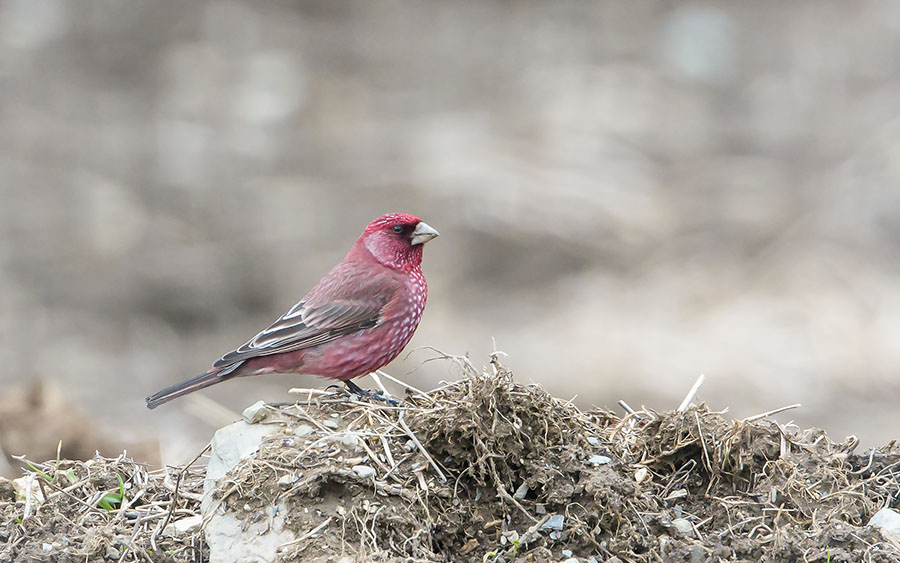 The gorgeous and localized subspecies of Great Rosefinch is a highly prized species and one that we will target on this wonderful tour of Georgia (photo Folkert de Boer).
The gorgeous and localized subspecies of Great Rosefinch is a highly prized species and one that we will target on this wonderful tour of Georgia (photo Folkert de Boer).
From here we head towards the Lagodekhi Nature Reserve which reaches up into the Greater Caucasus Mountains. Here we will take a walk through some of the oldest primary forest in Europe. Despite being in the shadow of the Greater Caucasus, this forest is lush and varied with many relict species like those found in subtropical forests.
This fascinating wilderness is home to the highly sought-after White-backed Woodpecker, a species which spreads across Eurasia but is not found west of central Europe. Other woodpeckers can be found here including Black Woodpecker, European Green Woodpecker, Lesser Spotted Woodpecker, Middle Spotted Woodpecker, and Great Spotted Woodpecker.
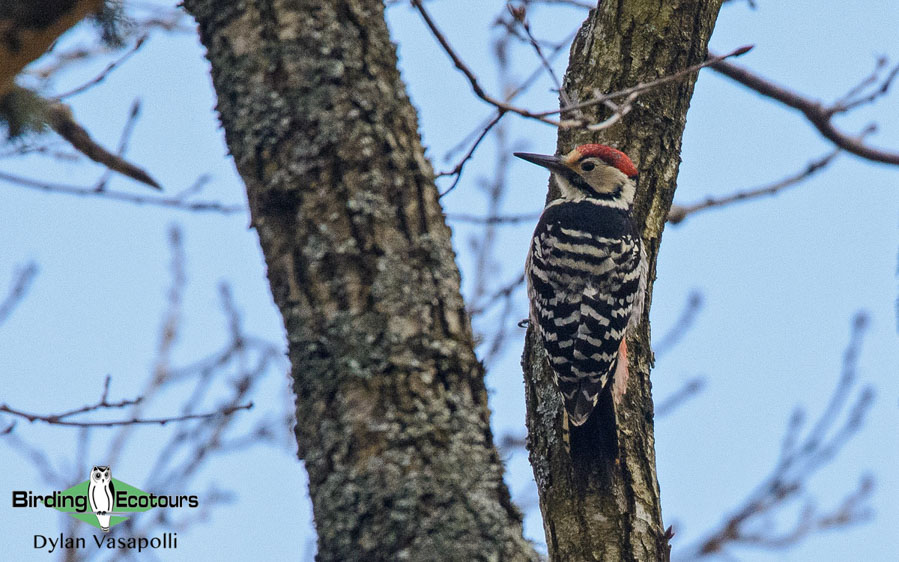 White-backed Woodpecker is a striking bird and one of several woodpeckers we could see.
White-backed Woodpecker is a striking bird and one of several woodpeckers we could see.
Other interesting species of this forest include Eurasian Nuthatch, White-throated Dipper, Redwing, Eurasian Bullfinch, and Mountain Chiffchaff, which is of the local lorenzii subspecies and a potential future split into a full species. After we have enjoyed this ancient forest and its birds we will continue to Tbilisi, stopping at the ancient town of Sighnaghi en route to take in its history and sensational views of the Greater Caucasus Mountains.
Overnight: Tbilisi
Day 7 – 9. Ananuri Fortress, The Terek River Valley, and Stepantsminda
Today we will once again leave Tbilisi, except on this occasion we will head north towards the wonderous Greater Caucasus Mountains. Our first stop is the Ananuri Fortress which overlooks the azure waters of the Zhinvali Reservoir. This is yet another beautiful spot to watch the superb Wallcreeper and we may also find the equally desirable Alpine Accentor lurking within the grounds of the fortress.
From here we are around two hours from Stepantsminda, which is tucked away deep in the Greater Caucasus Mountains and where we will spend the next few days. All being well, we will arrive late morning and will have a traditional Georgian lunch before beginning our birding for the afternoon. We will visit the Terek River and it is here we will look for two of Georgia’s “Big Five”, Güldenstädt’s Redstart and the Caucasian endemic rubicilla subspecies of Great Rosefinch.
We have timed this tour to coincide with peak snow levels which will push birds down from the higher areas of the mountains, and tours later in the season stand a high chance of missing Güldenstädt’s Redstart as a result of the birds moving higher out of range.
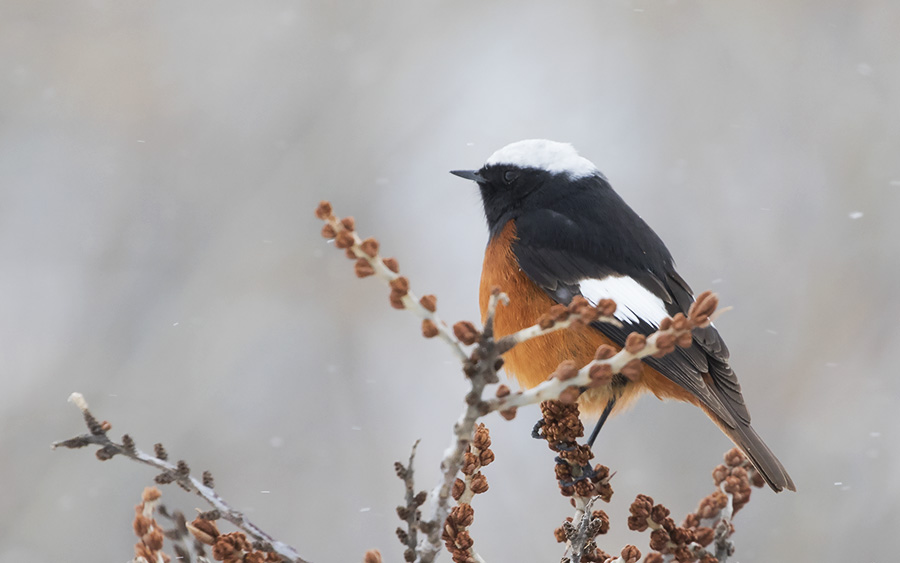 The beautiful Güldenstädt’s Redstart is one of Georgia’s “Big Five” and a top target for our tour (photo Alexander Rukhaia).
The beautiful Güldenstädt’s Redstart is one of Georgia’s “Big Five” and a top target for our tour (photo Alexander Rukhaia).
In the area around Stepantsminda there are several other interesting species with localized subspecies adding to the appeal. Here we should come across Ring Ouzel (amicorum subspecies), Horned (Shore) Lark (penicillata subspecies), Water Pipit (coutelli subspecies), Twite (brevirostris subspecies), Common Linnet, Red-fronted Serin, Red-billed Chough, Alpine Chough, White-throated Dipper, Grey Wagtail, Brambling, Eurasian Bullfinch, Rock Bunting, Eurasian Siskin, Fieldfare, Red (Common) Crossbill, and other interesting passerines. Birds of prey include three giants of the region, with Bearded Vulture, Griffon Vulture, and Golden Eagle all present.
Over the next two days we will once again target Georgia’s “Big Five” with two new species, the Near Threatened (BirdLife International) Caucasian Grouse and the mystical Caucasian Snowcock, an endemic of the Greater Caucasus Mountains. To find these two iconic birds we will head to the beautiful Kuro Gorge close to Stepantsminda, where we can also once again, find our two target birds from yesterday, Güldenstädt’s Redstart and Great Rosefinch. The presence of four of Georgia’s “Big Five” is what makes this part of the country such an incredible place for birding. We will also enjoy similar species to the previous day in the area.
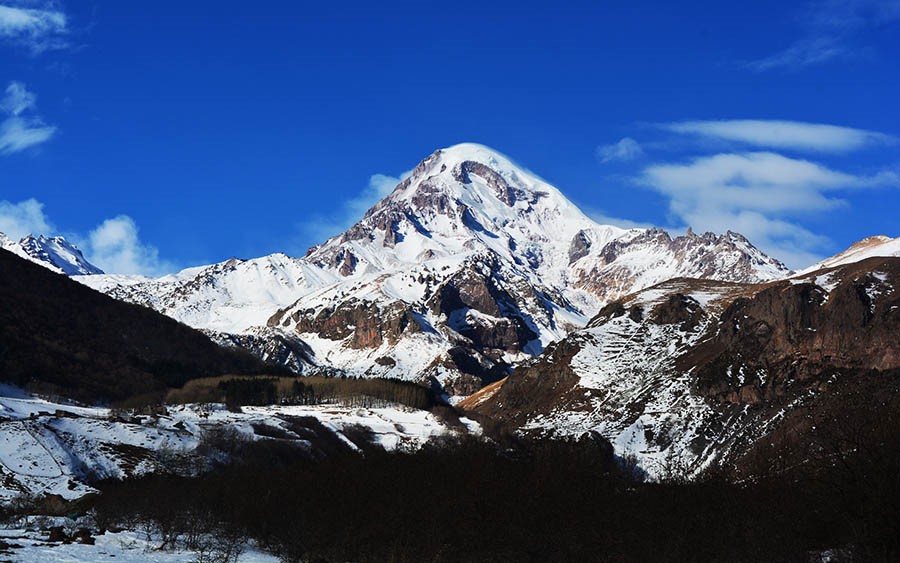 Mount Kazbek is one of many stunning scenes we will enjoy (photo Alexander Rukhaia).
Mount Kazbek is one of many stunning scenes we will enjoy (photo Alexander Rukhaia).
Aside from birds, we also have a chance of seeing the majestic Eastern Tur, This goat-antelope is a Near Threatened (IUCN) species with less than 25,000 left in the wild and another species which is endemic to the Greater Caucasus Mountains. We have also timed our tour to maximize our chances of seeing (European) Grey Wolf, which, in Georgia, numbers only about 1,000 animals. Due to the high amount of snow, these often-elusive canids come to the area around Stepantsminda to find food and with luck we may just get a sighting.
In Stepantsminda we may also take a walk up to the stunning Gergeti Trinity Church, which sits high above the village and makes a stunning end to our time in the Greater Caucasus Mountains.
Overnight (three nights): Stepantsminda
Day 10. Trusso Gorge, Jvari Pass, Gudauri, Mtshkheta, and the return to Tbilisi
Today we will make the journey back out of the mountains towards Tbilisi, stopping en route for birding along the way. Our first stop is the Trusso Gorge which sits at the southern edge of the huge Mount Kazbek, a dormant stratovolcano and the third highest peak in Georgia at an impressive 16,581 feet (5,054 meters).
Once again, we should come across a range of mountain passerines like Red-fronted Serin, Red-billed Chough, Alpine Chough, Water Pipit, Twite, Grey Wagtail, and Black Redstart but being at a lower altitude we may also find Mountain Chiffchaff, Common Chaffinch, Siberian Stonechat, and Blue Rock Thrush. We then continue down the mountains and once again try to spot Ring Ouzel, Horned (Shore) Lark, Water Pipit, Twite, and we may get the bonus of a stunning White-winged Snowfinch, a beautiful passerine of the mountain areas of Europe and Asia but very rare in this part of Georgia.
Our final stop in the mountains will be near the Guadauri ski center where we should once more find Alpine Accentor, raptors like Golden Eagle and Bearded Vulture, and large flocks of raucous Alpine Chough. From here, we will continue our descent back towards Tbilisi, stopping at the ancient town of Mtskheta for one last look at the stunning Greater Caucasus Mountains.
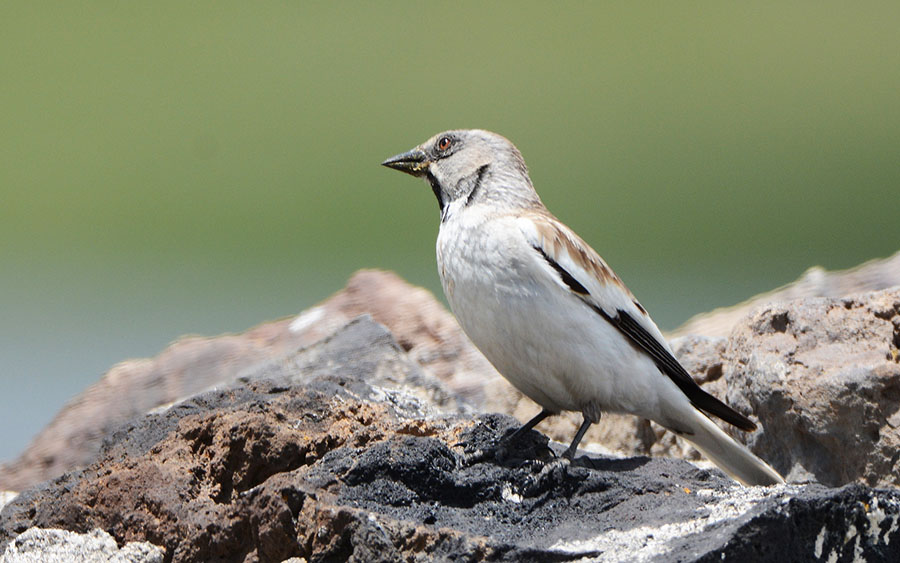 White-winged Snowfinch moves to lower elevations during the winter and can, with luck, be found during the tour, though it is not common in Georgia (photo Alexander Rukhaia).
White-winged Snowfinch moves to lower elevations during the winter and can, with luck, be found during the tour, though it is not common in Georgia (photo Alexander Rukhaia).
We will arrive back to Tbilisi with fantastic memories of a wonderful tour around this beautiful country. Here we will have our final traditional Georgian meal and your tour leader and guide will be on hand to discuss species identification and help you decide your “Bird of the Trip”, with so many on offer this will be a hard yet hopefully enjoyable task!
Overnight: Tbilisi
Day 11. Departure from Tbilisi Airport where the tour ends
A non-birding day. After our final traditional Georgian breakfast, we will depart our hotel for Tbilisi International Airport, with departures from the airport taking place in the morning.
Overnight: Not included
Please note that the itinerary cannot be guaranteed as it is only a rough guide and can be changed (usually slightly) due to factors such as availability of accommodation, updated information on the state of accommodation, roads, or birding sites, the discretion of the guides and other factors. In addition, we sometimes must use a different international guide from the one advertised due to tour scheduling.
Download ItineraryGeorgia: Private Spring Birding and Cultural Tour Report, March 2023
31 March – 10 April 2023
DOWNLOAD TRIP REPORT
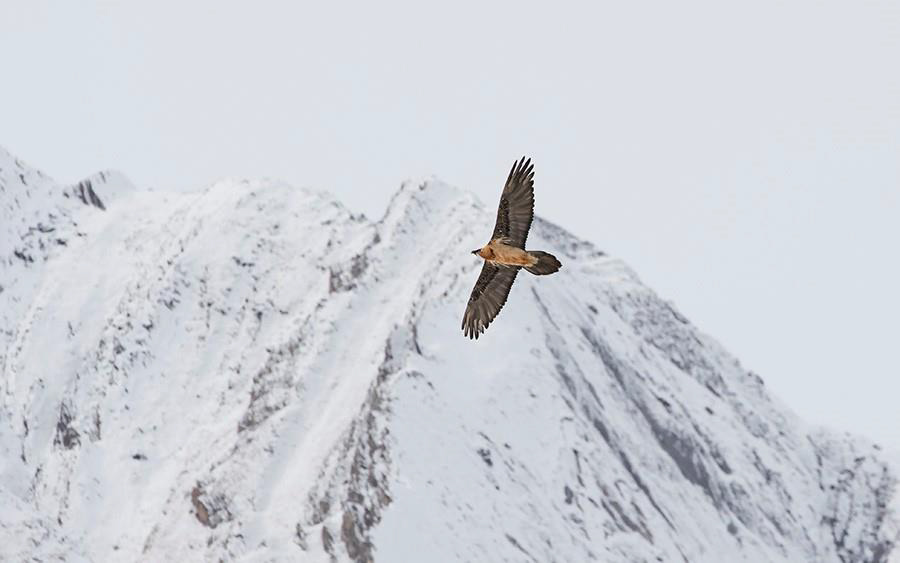
Bearded Vulture is one of many highly prized species in the Greater Caucasus mountains of Georgia (photo Alexander Rukhaia).
Overview
Our 11-day tour of Georgia began on the 31st of March 2023, in the glamourous city of Batumi, and concluded on the 10th of April 2023 in Tbilisi. Our trip around this beautiful country gave us many exciting species, including Caucasian Snowcock, Caucasian Grouse, Güldenstädt’s Redstart, Red-fronted Serin, Great Rosefinch, Citrine Wagtail, Common Crane (Archibaldii subspecies), Bearded Vulture, Alpine Chough, Turkestan Short-toed Lark, Mountain Chiffchaff, Krüper’s Nuthatch, Western Rock Nuthatch, Blue Rock Thrush, Siberian Stonechat, Isabelline Wheatear, and White-throated Dipper. A total of 136 bird species were recorded during the tour (three of these were “heard only”), with complete species lists at the end of this report.
I would like to thank Urban, Nancy, Wendy, and Karen for their company during the tour and of course Alex, our Georgian guide, for his excellent knowledge, logistics and planning, from start to finish. Not only did he make the trip a success, but he also ensured I received the correct medical attention when I fell ill and sadly could not finish the tour — for that I will always be grateful.
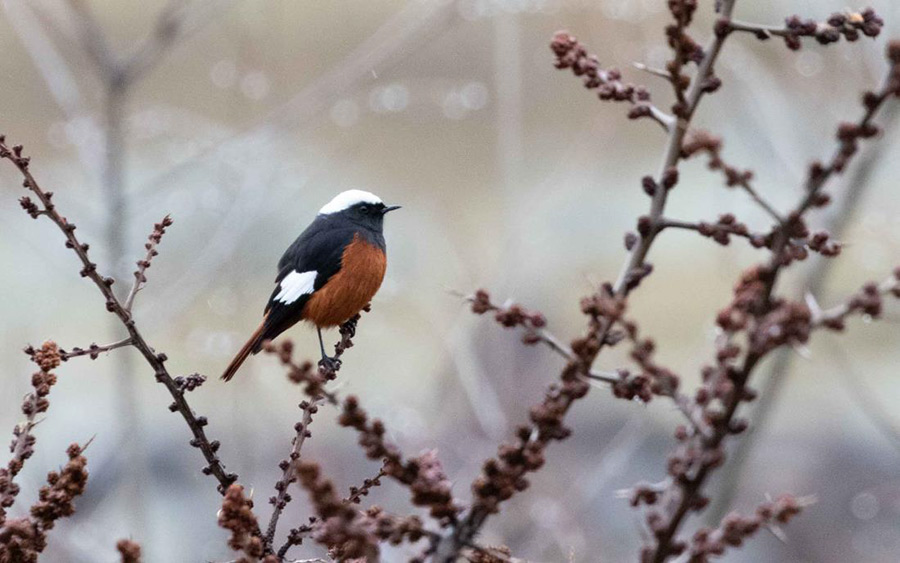
Güldenstädt’s Redstart is one of the star species of Georgia and we enjoyed great views on this tour (photo Alexander Rukhaia).
Detailed Report
Day 1, 31st March 2023. Arrival in Batumi
The first day of our tour would see us arrive in Batumi at 09:40am. From here we met our driver and transferred to our hotel for a short rest after our early start. With the weather from Istanbul following us here we limited our activities to cultural ones in the city, with visits to the Batumi Archaeological Museum and the city’s cathedral. We finished with a traditional Georgian meal at a vineyard outside the city.
Day 2, 1st April 2023. Birding Batumi and Chorokhi River Delta
Today we would explore some great birding locations around the city of Batumi. After breakfast we visited the famous Shuamta raptor watchpoint. Immediately it was obvious that raptors would be migrating north today as large kettles of Common (Steppe) Buzzard and Black Kite began to form over the coast. With these were also a few Lesser Spotted Eagle which stood out in the flocks, even at distance. One surprise species was a group of four Common Crane moving north at distance. Around the watchpoint a Mountain Chiffchaff was heard singing but sadly did not show.
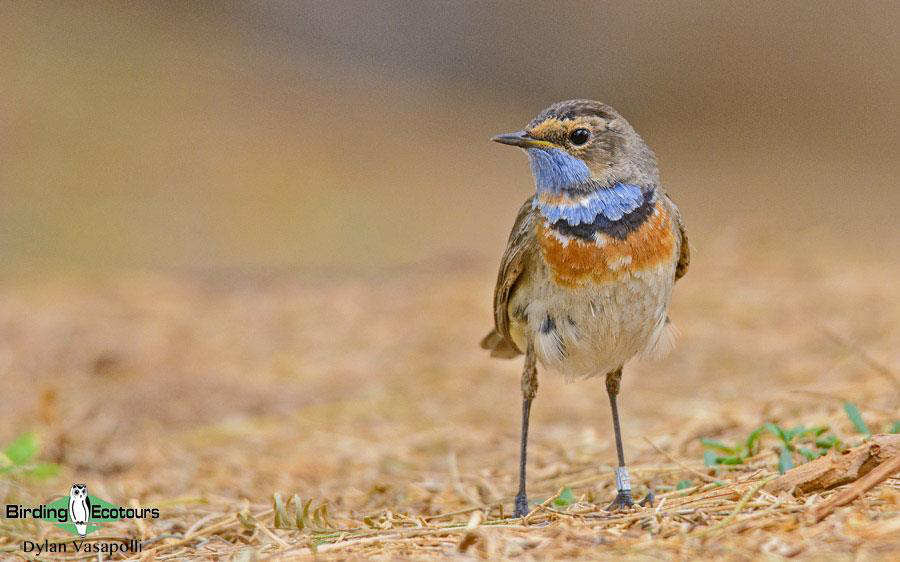
Bluethroat was a great addition to our list in the Chorokhi River Delta on the Black Sea coast of Georgia.
After lunch we headed to the south edge of Batumi to the wonderful Chorokhi River Delta. This myriad of ponds, pools, and reedbeds around the Chorokhi River is an incredible migrant trap and many birds were seen here. Standout species included Isabelline Wheatear, Siberian Stonechat, Short-toed Snake Eagle, Bluethroat, Red-crested Pochard, Black-throated Loon (Diver), Hen Harrier, and an early Willow Warbler. The backdrop of the sky above Batumi filled with birds of prey provided a spectacle that few places on earth can match.
After a long day in the field, we returned to Batumi for dinner.
Day 3, 2nd April 2023. Kutaisi with birding on route
Today we would head north towards the city of Kutaisi, one of the longest-inhabited cities in Europe. En route we would stop at Maltakva beach for some birding. This was a productive stop which gave us Garganey, Greater Scaup, Common Scoter, Red-breasted Merganser, Kentish Plover, Curlew Sandpiper, Slender-billed Gull, and migrating raptors like Western Marsh Harrier and Eurasian Sparrowhawk coming in from the sea.
After a picnic lunch we continued to Kutaisi where we would spend the night. Unfortunately, our Birding Ecotours guide, would be forced to leave the tour due to poor health, despite his best efforts to rejoin the tour in the following days. Fortunately, our fantastic local guide Alex continued the tour and provided the remainder of this trip report.
Day 4, 3rd April 2023. Borjomi and Akhaltsikhe
Today we would head south towards the region of Javakheti in southern Georgia. After a long drive through difficult mountain roads, we arrived at Borjomi where we explored the old part of the town and the central park. Birds seen here included Northern Raven, Coal Tit and Eurasian Nuthatch.
As the weather turned, we made a hasty retreat for our hotel in Akhaltsikhe. The poor weather continued, so we ordered a traditional meal at the hotel and enjoyed a bottle of Velvet Scoter wine, produced to support the conservation of this rare duck species in Georgia.
Day 5, 4th April 2023. Rabati Castle and Vardzia Cave Town
Today would be another day of culture as we visited the beautiful Rabati Castle and Vardzia Cave Monastary. Despite being cultural visits, we also enjoyed some great birds, including Common Whitethroat, Black Redstart, Rock Bunting, Western Rock Nuthatch, Blue Rock Thrush, Siberian Stonechat, and Red-fronted Serin.
In the evening we stayed at the quaint Valodia’s Cottage, which included great quantities of homemade wine and fabulous food.
Day 6, 5th April 2023. The road to Kazbegi via Khanchali and Bughdasheni Lakes
Today would be a real adventure as we traveled all the way from Georgia’s southern border with Turkey, to its northern border with Russia. En route we stopped at the managed reserves of Khanchali and Bughdasheni Lakes. These productive birding spots gave us one of the world’s rarest birds, the Trancaucasian subspecies of Common Crane (Grus grus archibaldii). Also seen here were Greylag Goose, Common Shelduck, Ruddy Shelduck, Armenian Gull, White Stork, Western Marsh Harrier, Black Redstart, and Siberian Stonechat.
The wind was really picking up now, so we decided to continue our journey and after a long day we arrived in the breath-taking mountains of Kazbegi.
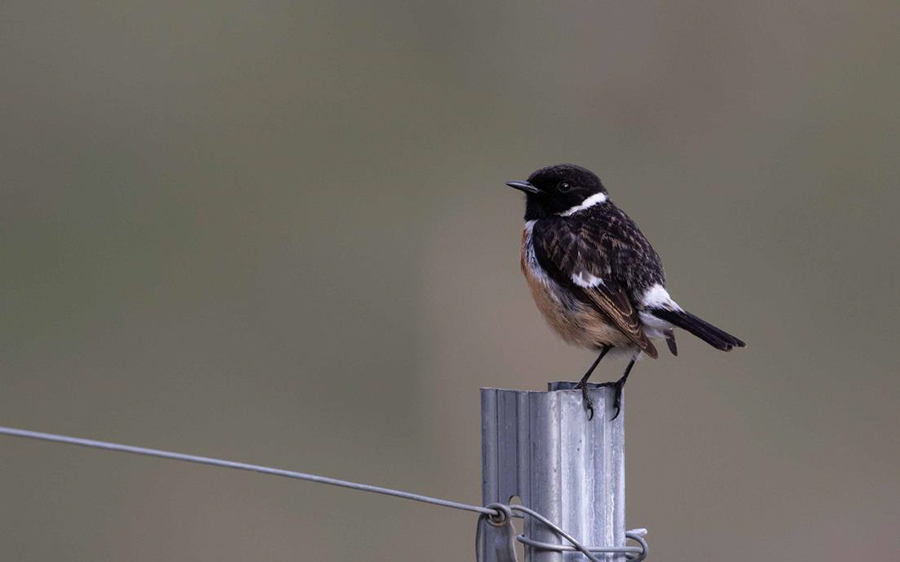
Siberian Stonechat is a striking bird and was seen regularly throughout the tour (photo Alexander Rukhaia).
Days 7-8, 6th-7th April 2023. The Kuro Gorge and Terek River Valley
For the next two days we explored the mighty Kuro Gorge and Terek River Valley around Stepantsminda. This is the land of some truly special birds and here we were able to enjoy White-throated Dipper, Caucasian Snowcock, Caucasian Grouse, Golden Eagle, Alpine Accentor, Güldenstadt’s Redstart, Wallcreeper, Bearded Vulture, Griffon Vulture, Black Kite, Red-billed Chough, Alpine Chough, Ring Ouzel, and Great Rosefinch, all amongst stunning scenery.
Our non-birding activities included a visit to the Gergeti Trinity Church, a breath-taking building surrounded by vast mountains, and the Ananuri Fortified Church complex. After two incredible days in the mountains, we headed back towards Tbilisi.
Day 9, 8th April 2023. Jvari Monastery, Svetitskhoveli Cathedral, and Koroji Pine Woods
Today the weather was not on our side and as such we had to make alternative plans. Our day began with some birding at breakfast where we enjoyed great views of Little Egret and Black-crowned Night Heron in a nesting colony near our hotel.
After breakfast we headed to Jvari Monastery near the town of Mtskheta. The weather became even worse as we arrived but despite this, we explored this beautiful building. Our next stop was Svetitskhoveli Cathedral. The weather here was calmer and after a short wait due to the Sunday service we were allowed to explore the cathedral. After a fantastic lunch we headed to Kojori Pine Woods where our number one target, Krüper’s Nuthatch, gave itself up with ease, allowing us to have fantastic views.
Day 10, 9th April 2023. David Gareji Monastery, Kumisi Lake, and Ponichala Forest Park
Our final full day saw us head south to the border with Azerbaijan. This semi-desert environment holds yet another historical wonder, the David Gareji Monastery. This fascinating monastery, hewn from rock, is truly a stunning place to spend time. Before we reached the monastery, we made a spontaneous stop at the KFT winery. By a stroke of luck, we were invited to join a wine tour. After seven different wines, brandy and a shot of chacha we took a more relaxed view on birding for the rest of the day.
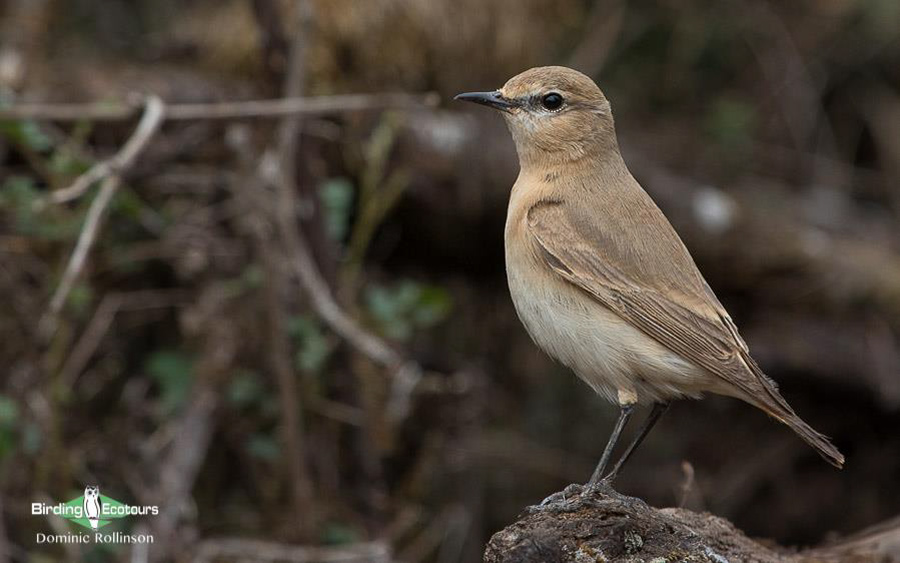
We enjoyed great views of Isabelline Wheatear while in Georgia.
After finally reaching the monastery, we managed some birding, with Chukar Partridge, Short-toed Snake Eagle, Northern Goshawk, Long-legged Buzzard, Eurasian Skylark, Siberian Stonechat, and Corn Bunting all on the list.
After lunch we visited the equally picturesque Kumisi Lake, south of Tbilisi, for our penultimate birding of the tour. Here we were able to locate species such as Ruddy Shelduck, Black-necked (Eared) Grebe, Black-winged Stilt, Marsh Sandpiper, Wood Sandpiper, Eurasian Hoopoe, Turkestan Short-toed Lark, Crested Lark, Isabelline Wheatear, and up to 40 Citrine Wagtails.
Our final stop was the Ponichala Forest Park, where Syrian Woodpecker was the main target and we duly added it to our list.
Our final dinner was enjoyed in Tbilisi where we also watched live Georgian dancing and singing.
Day 11, 10th April 2023. Departure from Tbilisi
Today we departed from Tbilisi airport, reflecting on a wonderful tour in this fascinating country.
Bird List – Following IOC (12.1)
Birds ‘heard only’ are marked with (H) after the common name, all other species were seen.
| Common Name | Scientific Name |
| Ducks, Geese, Swans (Anatidae) | |
| Greylag Goose | Anser anser |
| Common Shelduck | Tadorna tadorna |
| Ruddy Shelduck | Tadorna ferruginea |
| Garganey | Spatula querquedula |
| Northern Shoveler | Spatula clypeata |
| Mallard | Anas platyrhynchos |
| Eurasian Teal | Anas crecca |
| Red-crested Pochard | Netta rufina |
| Common Pochard | Aythya ferina |
| Tufted Duck | Aythya fuligula |
| Greater Scaup | Aythya marila |
| Common Scoter | Melanitta nigra |
| Red-breasted Merganser | Mergus serrator |
| Pheasants & Allies (Phasianidae) | |
| Caucasian Grouse | Lyrurus mlokosiewiczi |
| Caucasian Snowcock | Tetraogallus caucasicus |
| Chukar Partridge | Alectoris chukar |
| Swifts (Apodidae) | |
| Common Swift | Apus apus |
| Pigeons, Doves (Columbidae) | |
| Rock Dove | Columba livia |
| Eurasian Collared Dove | Streptopelia decaocto |
| Rails, Crakes & Coots (Rallidae) | |
| Eurasian Coot | Fulica atra |
| Little Crake | Zapornia parva |
| Cranes (Gruidae) | |
| Common Crane | Grus grus archibaldii |
| Grebes (Podicipedidae) | |
| Little Grebe | Tachybaptus ruficollis |
| Great Crested Grebe | Podiceps cristatus |
| Black-necked Grebe | Podiceps nigricollis |
| Oystercatchers (Haematopodidae) | |
| Eurasian Oystercatcher | Haematopus ostralegus |
| Stilts, Avocets (Recurvirostridae) | |
| Black-winged Stilt | Himantopus himantopus |
| Plovers (Charadriidae) | |
| Common Ringed Plover | Charadrius hiaticula |
| Little Ringed Plover | Charadrius dubius |
| Kentish Plover | Charadrius alexandrinus |
| Sandpipers, Snipes (Scolopacidae) | |
| Black-tailed Godwit | Limosa limosa |
| Ruff | Calidris pugnax |
| Curlew Sandpiper | Calidris ferruginea |
| Dunlin | Calidris alpina |
| Common Snipe | Gallinago gallinago |
| Common Sandpiper | Actitis hypoleucos |
| Green Sandpiper | Tringa ochropus |
| Common Redshank | Tringa totanus |
| Marsh Sandpiper | Tringa stagnatilis |
| Wood Sandpiper | Tringa glareola |
| Common Greenshank | Tringa nebularia |
| Gulls, Terns, Skimmers (Laridae) | |
| Slender-billed Gull | Chroicocephalus genei |
| Black-headed Gull | Chroicocephalus ridibundus |
| Mediterranean Gull | Ichthyaetus melanocephalus |
| Yellow-legged Gull | Larus michahellis |
| Armenian Gull | Larus armenicus |
| Sandwich Tern | Thalasseus sandvicensis |
| Loons (Gaviidae) | |
| Arctic Loon (Black-throated Diver) | Gavia arctica |
| Storks (Ciconiidae) | |
| White Stork | Ciconia ciconia |
| Cormorants, Shags (Phalacrocoracidae) | |
| Great Cormorant | Phalacrocorax carbo |
| Herons, Bitterns (Ardeidae) | |
| Eurasian Bittern | Botaurus stellaris |
| Black-crowned Night Heron | Nycticorax nycticorax |
| Grey Heron | Ardea cinerea |
| Great Egret | Ardea alba |
| Little Egret | Egretta garzetta |
| Kites, Hawks, Eagles (Accipitridae) | |
| Bearded Vulture | Gypaetus barbatus |
| Griffon Vulture | Gyps fulvus |
| Short-toed Snake Eagle | Circaetus gallicus |
| Lesser Spotted Eagle | Clanga pomarina |
| Golden Eagle | Aquila chrysaetos |
| Eurasian Sparrowhawk | Accipiter nisus |
| Northern Goshawk | Accipter gentillis |
| Western Marsh Harrier | Circus aeruginosus |
| Hen Harrier | Circus cyaneus |
| Black Kite | Milvus migrans |
| Long-legged Buzzard | Buteo rufinus |
| Common Buzzard | Buteo buteo |
| Owls (Strigidae) | |
| Little Owl | Athene noctua |
| Hoopoes (Upupidae) | |
| Eurasian Hoopoe | Upupa epops |
| Woodpeckers (Picidae) | |
| Middle Spotted Woodpecker (H) | Dendrocoptes medius |
| Syrian Woodpecker | Dendrocopos syriacus |
| Black Woodpecker (H) | Dryocopus martius |
| European Green Woodpecker (H) | Picus viridis |
| Caracaras, Falcons (Falconidae) | |
| Common Kestrel | Falco tinnunculus |
| Crows, Jays (Corvidae) | |
| Eurasian Jay | Garrulus glandarius |
| Eurasian Magpie | Pica pica |
| Red-billed Chough | Pyrrhocorax pyrrhocorax |
| Alpine Chough | Pyrrhocorax graculus |
| Western Jackdaw | Coloeus monedula |
| Hooded Crow | Corvus cornix |
| Northern Raven | Corvus corax |
| Tits, Chickadees (Paridae) | |
| Coal Tit | Periparus ater |
| Eurasian Blue Tit | Cyanistes caeruleus |
| Great Tit | Parus major |
| Larks (Alaudidae) | |
| Eurasian Skylark | Alauda arvensis |
| Crested Lark | Galerida cristata |
| Greater Short-toed Lark | Calandrella brachydactyla |
| Turkistan Short-toed Lark | Alaudala heinei |
| Swallows, Martins (Hirundinidae) | |
| Barn Swallow | Hirundo rustica |
| Common House Martin | Delichon urbicum |
| Bushtits (Aegithalidae) | |
| Long-tailed Tit | Aegithalos caudatus |
| Leaf Warblers & Allies (Phylloscopidae) | |
| Willow Warbler | Phylloscopus trochilus |
| Mountain Chiffchaff | Phylloscopus sindianus |
| Common Chiffchaff | Phylloscopus collybita |
| Sylviid Babblers (Sylviidae) | |
| Common Whitethroat | Curruca communis |
| Nuthatches (Sittidae) | |
| Krüper’s Nuthatch | Sitta krueperi |
| Western Rock Nuthatch | Sitta neumayer |
| Eurasian Nuthatch | Sitta europaea |
| Wallcreeper (Tichodromidae) | |
| Wallcreeper | Tichodroma muraria |
| Treecreepers (Certhiidae) | |
| Eurasian Treecreeper | Certhia familiaris |
| Starlings, Rhabdornis (Sturnidae) | |
| Common Starling | Sturnus vulgaris |
| Thrushes (Turdidae) | |
| Song Thrush | Turdus philomelos |
| Common Blackbird | Turdus merula |
| Ring Ouzel | Turdus torquatus |
| Chats, Old World Flycatchers (Muscicapidae) | |
| European Robin | Erithacus rubecula |
| Bluethroat | Luscinia svecica |
| Black Redstart | Phoenicurus ochruros |
| Güldenstädt’s Redstart | Phoenicurus erythrogastrus |
| Common Redstart | Phoenicurus phoenicurus |
| Blue Rock Thrush | Monticola solitarius |
| Whinchat | Saxicola rubetra |
| European Stonechat | Saxicola rubicola |
| Siberian Stonechat | Saxicola maurus |
| Northern Wheatear | Oenanthe oenanthe |
| Isabelline Wheatear | Oenanthe isabellina |
| Dippers (Cinclidae) | |
| White-throated Dipper | Cinclus cinclus |
| Old World Sparrows, Snowfinches (Passeridae) | |
| Rock Sparrow | Petronia petronia |
| Eurasian Tree Sparrow | Passer montanus |
| House Sparrow | Passer domesticus |
| Accentors (Prunellidae) | |
| Alpine Accentor | Prunella collaris |
| Dunnock | Prunella modularis |
| Wagtails, Pipits (Motacillidae) | |
| Western Yellow Wagtail | Motacilla flava |
| Citrine Wagtail | Motacilla citreola |
| Grey Wagtail | Motacilla cinerea |
| White Wagtail | Motacilla alba |
| Water Pipit | Anthus spinoletta |
| Finches, Euphonias (Fringillidae) | |
| Common Chaffinch | Fringilla coelebs |
| Eurasian Bullfinch | Pyrrhula pyrrhula |
| Great Rosefinch | Carpodacus rubicilla |
| European Greenfinch | Chloris chloris |
| Common Linnet | Linaria cannabina |
| European Goldfinch | Carduelis carduelis |
| Red-fronted Serin | Serinus pusillus |
| Buntings (Emberizidae) | |
| Corn Bunting | Emberiza calandra |
| Rock Bunting | Emberiza cia |
| Common Reed Bunting | Emberiza schoeniclus |
| Total seen | 133 |
| Total heard only | 3 |
| Total recorded | 136 |
Mammal List
The following notation after species names is used to show conservation status following IUCN Red List: NT = Near Threatened
| Common Name | Scientific Name |
| Goat-Antelopes (Caprinae) | |
| Eastern Tur – NT | Capra cylindricornis |
| Total | 1 |
DOWNLOAD TRIP REPORT
This is a sample trip report. Please email us ([email protected]) for more trip reports from this destination.
During this winter Georgia tour we will be driving around in a comfortable vehicle. This tour does involve longer walks than on many of our other tours due to the nature of the environment we will be birding in, including on some rough/steep terrain. Altitude should not be a major factor during much of the tour, but during our time in the Greater Caucasus we will be at around 6,500 feet (2,000 meters) above sea level which you may need to consider as we will be undertaking walks at this altitude. We will obviously take as much time as is needed as we walk about, to ensure everyone is able to get around safely.
The start of our tour in Tbilisi will see daytime temperatures range from 54 – 64oF (12 – 18oC), we then head east to the steppes and plains around Dedoplistskaro. Here we can expect the weather to be noticeably more varied than in Tbilisi and temperatures could be as low as 41 – 48oF (5 – 8oC) but as high as 66 – 73oF (19 – 23oC). Finally, we head to the Greater Caucasus Mountains at Stepantsminda. Due to the altitude of around 6,500 feet (2,000 meters), the weather here is expected to be colder, around 32 – 41oF (0 – 5oC) and the chance of snow is high. This weather could prove to be a good thing for us as it makes the birding far easier if the snow level is lower as it pushes the key target birds down from the higher peaks. By pushing the tour to later in the year reduces the chances of seeing species like Güldenstädt’s Redstart, something to consider when looking at tour dates if that species and others of the high mountains is of major importance to you.
Georgian food and hospitality are both excellent and all your accommodation will have private bathrooms and will be well appointed in a local style. We will be in the heart of this traditional and fascinating country where the wildlife is abundant, even in the villages and towns and is sure to help contribute to what is to be an exciting, once-in-a-lifetime bird holiday.
